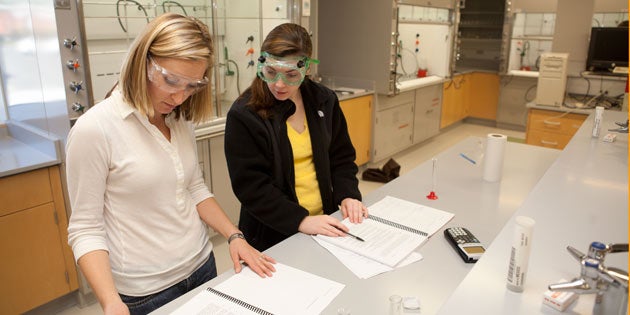Since 2011, the College of Charleston’s Department of Chemistry and Biochemistry has published 54 research articles with 26 undergraduate student co-authors. Chemistry and biochemistry faculty members afford students the opportunity to conduct hands-on research starting their sophomore year or even earlier. Department chair Pamela Riggs-Gelasco believes these research experiences benefit students in many ways.
“They can discover their passions through research,” Riggs-Gelasco said. “I often see students who think they want to go to dental or medical or pharmacy school but when they get involved in research they realize they are truly interested in it, so they end up changing their plans. Since it’s the first time students really do science, it allows them to find out if they love it.” 90 Percent of the Chemistry and Biochemistry majors that go on to pursue a PhD did research at the College.
Learning to love science is made easier with a faculty dedicated to working alongside students to develop their research skills and investigative instincts. “We all really love working with students, which is why we’re here instead of at a big research university.” It is gratifying as an educator to see students evolve as researchers. Riggs-Gelasco explains “Getting to the point where students can design their own experiments can take a few years, which is why we encourage them to start early in their career – so they have time to develop into real investigators.”
Research is fueled by external grants to faculty members for their research. The department was recently awarded a National Science Foundation (NSF) grant for $319,000 for the purchase of a Nuclear Magnetic Resonance spectrophotometer (NMR). The grant was a department wide effort led by Principal Investigator Justin Wyatt and co-PIs Wendy Cory, Marcello Forconi, Brooke Van Horn, and Tim Barker. The instrument allows students to characterize the chemical compounds they’re examining for research projects.
“It was absolutely critical that we were successful in procuring the NMR,” Riggs-Gelasco said. The current NMR was purchased in 1989 and needed to be replaced and upgraded to meet the needs of the department. “Almost everyone in the department uses the NMR, whether you’re trying to figure out what certain pharmaceutical drugs degrade to in the environment or whether you’re working in a synthetic lab analyzing the result of a chemical reaction. It can train about 100 students a year.”
This grant is the second one in two years for major research instrumentation in the department. In 2012, Wendy Cory received a $277,000 grant for the purchase of a Ultra High Pressure Liquid Chromatography-mass spectrometer, another collaborative grant that included faculty in Geology. Cory added, “We have seen that our students who have conducted undergraduate research with this kind of cutting-edge technology are more attractive to graduate schools and for prestigious fellowships and research grants.”
Riggs-Gelasco says the research opportunities offered to undergraduates at the College are unique and distinct from those at research universities. “Our faculty members work side by side with undergraduates at the bench and that just doesn’t happen at research universities. It happens here because we hire people who will fit in with our department’s goals and educational philosophy of using research to teach students.”
The success of Riggs-Gelasco’s recruitment efforts is clear in the numbers alone – the average publication rate for science faculty at similar schools is one paper every other year, but her department is nearly double that. Additionally, the School of Sciences and Mathematics began the 2014-15 academic year with $2.5 million in research grants. Beyond statistics, though, “We recruit faculty members who, while they’re capable of competing at research universities, are passionate about mentorship,” Riggs-Gelasco explained.
Ultimately, a passion for research may spark the chemistry and biochemistry program’s exciting portfolio of research projects, but the passion for mentorship makes it unique to the College. “Students are granted truly special opportunities here,” Riggs-Gelasco said. “Opportunities that benefit all of us in the department in many ways.”





